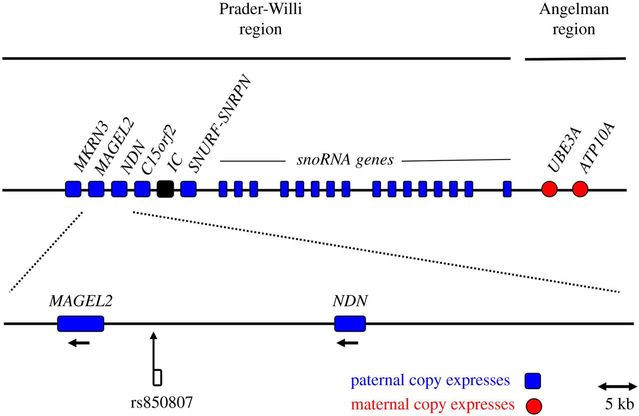Genetics
A DNA Marker For Paranoia As Predicted
An expectation that genes for psychosis are on chromosome 15 has been confirmed.
Posted February 3, 2018
As I remarked at the beginning of the very first of these posts, back in 2009, the history of science is not always what it ought to be, and today, almost a decade later, I must confess that the fate of the imprinted brain theory has not so far turned out as I expected. At the beginning, I naively believed that genetics/genomics was advancing so fast that key imprinted genes predicted by the theory would readily be found and its validity either confirmed or disproved quite quickly.
What I did not expect was that the diametric model of the mind would instead turn out to be the first part of the theory to be stunningly confirmed in terms of brain structure and anatomy—something which at the beginning I doubted would ever be possible.
However, from the start I was sure that, if we were going to find the genes predicted, at least some of them would be found on chromosome 15 in a region associated with two paediatric syndromes with opposite symptoms, Angelman and Prader-Willi syndrome (PWS, below). As I put it in an email to a colleague in the summer of 2000:

For reasons too complicated to explain in full I have a hunch that autism is to paranoia (and perhaps some other schizophrenias) what Prader-Willi syndrome is to Angelman: ie the outcome of oppositely imprinted genes. I think that excess paternally-active or deficient maternally-active genes may be implicated in autism, which results in hypo-mentalism (Baron-Cohen's 'mindblindness'): deficient sensitivity to direction of gaze, deficits in understanding intention and shared attention, verbal impairment, mechanistic thinking etc. Paranoia shows hyper-mentalism: morbid sensitivity to direction of gaze (delusions of being watched or spied on), excessive sensitivity to intention and shared attention (belief in conspiracies), excessive but internalized verbalization (hearing voices), psychic credulity etc. etc. and may be the result of excessively maternal and/or deficient paternal gene activity...
Frustratingly until now, direct evidence of any gene or genes implicated in psychosis in PWS has been lacking, despite the fact that PWS patients with both copies of chromosome 15 from the mother show very high rates of eventual psychosis. But now a study by Bernard Crespi, Silven Read, Iiro Salminen, and Peter Hurd has remedied the situation and found in the title of their paper, A genetic locus for paranoia on an imprinted region of chromosome 15, just as the imprinted brain theory predicts and I expected from the start.

As the authors explain, they phenotyped a large population of typical individuals for schizophrenia spectrum and autism-spectrum traits, and genotyped them for the single-nucleotide polymorphism (SNP, or snip) rs850807, which is linked to two PWS genes, MAGEL2 and NDN (above). They report that
genetic variation in rs850807 was strongly and exclusively associated with the ideas of reference subscale of the schizophrenia spectrum, which is best typified as paranoia. These findings provide a single-locus genetic model for analysing the neurological and psychological bases of paranoid thinking, and implicate imprinted genes, and genomic conflicts, in human mentalistic thought.
The main results of this study are twofold. First, the data support
the hypothesis that the SNP rs850807 is associated strongly and specifically with ideas of reference, which indicate aspects of paranoia. As such, neurotypical individuals who differ in their rs850807 genotype exhibit psychological variation that reflects, in greatly reduced magnitude, this psychiatric characteristic that is commonly found among individuals with PWS who develop forms of psychosis. The specificity of these results, in that Ideas of Reference but not perceptual aberrations, magical thinking, other schizotypal or autism spectrum traits, or total schizotypy or autism, are associated with rs850807 genotype, implies that the neurogenetic circuitry mediated by this locus subserves paranoid ideation.
They add that in the the Schizotypal Personality Questionnaire they used,
the Ideas of Reference subscale reflects endorsement of statements that others ‘are talking about me’, ‘have it in for me’, are ‘not trustworthy’, ‘take notice of me’, ‘are watching me’ and ‘want to take advantage of me’. As such, it includes multiple facets of paranoid thinking, including imagined and delusional thoughts, actions and plans.
Second, the researchers report that
These results … suggest that the psychiatric correlates of this syndrome exhibit a mosaic of genetic underpinnings that encompass at least two loci (since paranoia represents only one psychological aspect of PWS), and that presumably involve dosages of multiple brain-expressed imprinted genes. Future work should be directed towards replication in other populations, and elucidating the precise functional-genetic and epigenetic mechanisms of the psychological trait associations with rs850807 reported here, to determine what SNP, haplotype and gene are responsible for the patterns observed.
Finally, and almost a decade later than I expected, the first direct evidence of the imprinted genes whose conflicting pattern of interaction underlie the diametric model has been found. With stunning indirect evidence for the theory from a huge data sample already published, I expect this to be just the start of something that no amount of thought policing will be able to silence in the longer run.
Postscript added 20 March 2019:
According to a pre-print available on ResearchGate, UBEA3, shown in red on the right of the diagram above and encoding an E3 ubiquitin ligase protein expressed only from the maternal copy in neurons, has also now been confirmed as a gene which obeys the diametric prediction. According to the authors of this study:
to the extent that reduced expression of UBE3A mediates the expression of autism spectrum conditions, and higher expression of this gene mediates the expression of schizotypy, schizophrenia, and psychosis, the psychiatric and psychological effects of this gene would support the model developed by Crespi and Badcock (2008), whereby autism and psychotic-affective conditions represent diametric, opposite disorders mediated in part by imprinted gene effects.




